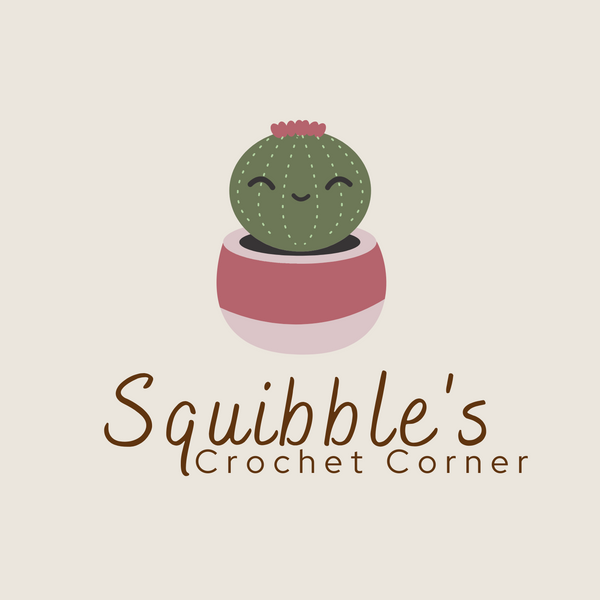Are you new to crocheting? Or perhaps you’ve been crocheting for a while but haven’t tried amigurumi yet? I have the perfect guide for you! In this blog post, I will show you how to crochet seven essential stitches needed for amigurumi. Yes, you read that right—only seven stitches! Most amigurumi patterns primarily use the first three, but I’ve included a few additional stitches that often appear in my patterns. Contrary to popular belief, amigurumi isn't just about single crochet. Make sure to read until the end for a tutorial on some must-know techniques!
Pin it to Save it for Later!
Want a Free PDF Guide for Each Stitch?
To download the full printable PDF guide, click here.
Chain (ch)
The most basic stitch! I first learned to crochet by making a long chain. Chains are essential in almost every pattern.

Step 1: Yarn over, pull loop through the loop on the hook.
Step 2: Repeat step 1 to create the required number of chs in the pattern.
Prefer to Watch and Learn?
Slip Stitch (sl st)
Slip stitches can be used in a variety of ways. I have used them to create detail on flowers and leaves, such as in the Valentine’s Pink Anthurium. They can also be used to create different bends and shapes.

Step 1: Insert hook into designated stitch.
Step 2: Yarn over, pull loop through stitch and loop on hook.
Single Crochet (sc)
This is probably the most commonly used stitch in amigurumi. If you must know any stitch, it’s this one! Almost every amigurumi pattern uses the single crochet stitch.

Step 1: Insert hook into designated stitch.
Step 2: Yarn over, pull loop through stitch. You should have two loops on the hook.
Step 3: Yarn over, pull loop through both loops on hook.
Half Double Crochet (hdc)
Probably my favorite stitch, shhh don’t tell single crochet 😂I love using this stitch to crochet flower petals and leaves.

Step 1: Yarn over, insert hook into designated stitch.
Step 2: Yarn over, pull loop through stitch. You should have three loops on the hook.
Step 3: Yarn over, pull loop through all three loops on the hook.
Double Crochet (dc)
A double crochet is just a slightly taller stitch than a half double crochet. This is another stitch I love to add to my flower patterns!

Step 1: Yarn over, insert hook into designated stitch.
Step 2: Yarn over, pull loop through stitch. You should have three loops on the hook.
Step 3: Yarn over, pull loop through first two loops. You should have two loops on the hook.
Step 4: Yarn over, pull loop through two remaining loops on the hook.
Treble Crochet (tr)
Although not as commonly used, I have used the treble stitch to help create more height on my flower petals, such as in the Sunflower Buddy Collection.

Step 1: Yarn over two times, insert hook into designated stitch.
Step 2: Yarn over, pull loop through stitch. You should have four loops on the hook.
Step 3: Yarn over, pull loop through first two loops. You should have three loops on the hook.
Step 4: Yarn over, pull loop through first two loops. You should have two loops on the hook.
Step 5: Yarn over, pull loop through remaining two loops.
Bobble Stitch (bo)
A bobble stitch is a group of several double crochet stitches joined at both top and bottom. The number of double crochet stitches in the bobble stitch can change depending on the pattern. Refer to the pattern for specific instructions. Bobble stitches can be used to create small bumps in your creations, mimicking stubby arms and feet or even shapes in plants such as the Car Hanging Plant Collection.

Step 1: Yarn over, insert hook into designated stitch.
Step 2: Yarn over, pull loop through stitch. Yarn over, pull loop through first two loops on the hook.
Step 3: Repeat steps 1 & 2 until you have six loops on the hook.
Step 4: Yarn over, pull loop through all six remaining loops.
Must-Know Techniques
Magic Ring (mr)
When I first started exploring the world of amigurumi, I quickly realized that I needed to master a technique called the magic ring to crochet in the round. Honestly, it took me days to get the hang of it, but once I did, it became second nature. I want to break down the magic ring technique for you in the simplest terms possible, sharing my personal method. I hope you find it helpful!

Step 1: With the palm of your hand facing towards you, take the end of the yarn, place it in between your pinky finger and ring finger, leaving a short yarn tail.
Step 2: Wrap the yarn around your ring, middle, and index finger and back in between your pinky and ring finger.
Step 3: Wrap the yarn around your three fingers again, forming an X on the palm side of your hand, and back in between your pinky and ring finger.
Step 4: Insert the hook underneath the yarn of the top right corner of the X made with the yarn in step 3.
Step 5: With the hook, pull the yarn of the top left corner underneath the X, twisting the hook to form a loop on the hook.
Step 6: Flip your hand over, pull the bottom piece of yarn through the loop on the hook.
Step 7: Crochet the designated number of stitches in the magic ring, making sure to crochet around the magic ring and tail. Pull the tail to close the magic ring.
Magic Ring Alternative: Ch 2 Method
If you struggle with crocheting magic ring, I have an easy alternative for you! The ch 2 method is an easy alternative that mimics a magic ring.

Step 1: Wrap yarn around the hook, forming a loop. Ch 2.
Step 2: Crochet the designated number of stitches in second ch from hook.
Step 3: Pull yarn tail tight to close.
Front Loop Only (FLO) & Back Loop Only (BLO)
Crocheting in the front loops only or the back loops only can help make different shapes in amigurumi. For example, I often use this technique to crochet pots.
While holding your work, look at the top of the stitches. The top of the stitches forms a sideways “V” shape. The side closest to you is the front loop and the side farthest is the back loop.

To crochet in the front loops, insert the hook into the side of the “V” closest to you, and complete the stitch. You will notice that the back loop of the stitch is left unworked.

To crochet in the back loops, insert the hook into the center of the “V” and under the back loop, and complete the stitch. You will notice that the front loop of the stitch is left unworked.

I hope you found this helpful and that it encourages you to try out more amigurumi patterns! If you have any questions, feel free to reach out to me through my website www.squibblescrochetcorner.com. Happy crocheting!
Here are some easy amigurumi patterns to try out:


